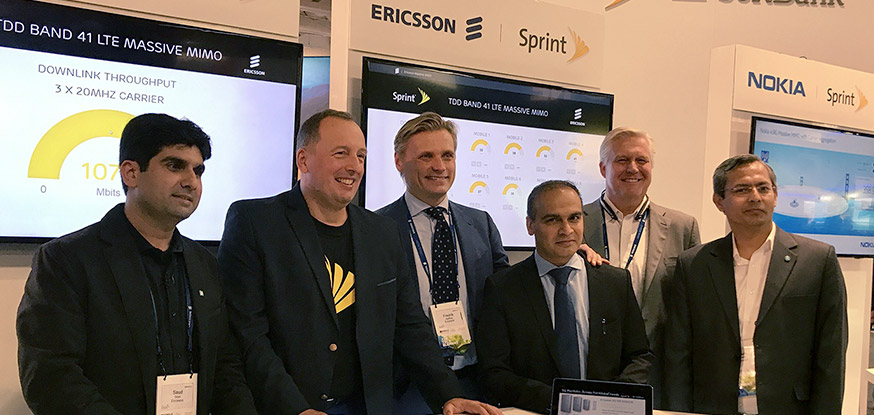At Mobile World Congress Americas, US telecom provider Sprint and Ericsson unveiled the results of the first US 2.5GHz Massive MIMO (multiple input, multiple output) field tests conducted in Seattle, Washington and Plano, Texas using Sprint's spectrum and Ericsson's 64T64R (64 transmit, 64 receive) radios.
Sprint and Ericsson are preparing for commercial deployment next year, with Massive MIMO capable of increasing Sprint's network capacity up to ten times. Testing of Massive MIMO on the Sprint LTE Plus network in downtown Seattle showed a capacity increase of approximately four times compared to an 8T8R antenna.
To showcase this capacity, Sprint convened 100 people with Samsung Galaxy S7 phones and ran simultaneous file downloads on a timed-test on all networks. The testing showed a 100 percent success rate on the Massive MIMO-powered Sprint network, which was a significantly higher result compared to the other networks.
In Plano, Texas, Sprint and Ericsson also recently tested Ericsson's 64T64R Massive MIMO radios reaching peak speeds of more than 300 Mbps using a single 20 MHz channel of 2.5 GHz spectrum.
For both field trials, Ericsson provided the radio network infrastructure and backhaul equipment. Sprint and Ericsson together developed the test cases and requirements, which included a variety of performance scenarios involving multi-user and non-stationary testing.
The Radio Network infrastructure included Ericsson's next-generation 5G-ready AIR6468 radio, and the backhaul equipment utilized the MINI-LINK 6352 R2 microwave radios which can provide up to 10 Gbps of backhaul, future proofing the network for 5G.
"Massive MIMO is a game changer for adding capacity to our network and taking LTE Plus to the next level," said Dr. John Saw, Sprint CTO. "This technology is a tremendous competitive advantage for Sprint, enabling us to maximize our deep 2.5 GHz spectrum holdings. Massive MIMO will be key to meeting our customers' growing demand for unlimited data, as well as offering Gigabit LTE and 5G services."
The companies will use the field trial results in preparation for commercial deployment of Massive MIMO in the US beginning in 2018. In cities across the US, Sprint plans to deploy 64T64R Massive MIMO radios using its 2.5 GHz spectrum to increase capacity up to ten times.
The technology will become part of Sprint's extended network toolbox as it works to densify and optimize the network, providing more capacity, better reliability, and overall improved performance for customers. In addition, Massive MIMO is slated to power Gigabit LTE services, and it will be a key element of Sprint's 5G network.
"Ericsson and Sprint have been collaborating on new technologies and continually evolving Sprint's LTE network, laying the foundation for 5G," said Nishant Batra, Head of Network Infrastructure at Ericsson.
"Our next-generation 5G-ready TDD 64T64R Massive MIMO radio (AIR6468) will help maximize spectral efficiency of Sprint's 2.5 GHz network," Batra added. "It will also provide a cost-efficient way to support their customers' growing appetite for increased capacity and high-speed data services. This will be the industry's first live eCPRI installation, which allows for several deployment and performance advantages to operators in the 5G era."
Massive MIMO is a differentiator for Sprint because it can be easily deployed on high-band spectrum such as Sprint's 2.5 GHz spectrum. Massive MIMO radios can support high-frequency bands with a small form factor, whereas the physics of lower-frequency spectrum bands would require radios far too large in size to manufacture and deploy on a broad scale.

